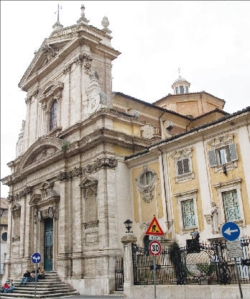Church ties cardinal to Rome
ROME--Until 1150, the pastors of Rome elected the pope from among their ranks. Tying them to that tradition and the diocese of the pope, modern cardinals receive honorary title to a Roman church.
At the Ordinary Public Consistory March 24, Pope Benedict XVI assigned Cardinal Seán P. O’Malley the titular church of Santa Maria della Vittoria (St. Mary of the Victory).
A small church--remarkably close to St. Susanna, the titular church of former Boston archbishop, Cardinal Bernard Law--it is run by the Order of Discalced Carmelite Friars.
The simple stone façade of the building conceals the elaborate baroque design within. Thousands flock to the church each year to view its many works of art.
Perhaps its greatest treasure is a sculpture created by Gian Lorenzo Bernini entitled “Ecstasy of St. Theresa.” Considered a masterpiece of baroque art, the marble sculpture is nestled in a side chapel to the left of the main altar.
The church, built by the Discalced Carmelites in the 1600s, was named in honor of a victory by Catholic forces over Protestants in the Battle of the White Mountain fought in 1620 near Prague.
The victory, which was decisive in retaining the Catholic faith in Bohemia (a region of what is now the Czech Republic) was attributed to the intervention of the Virgin Mary. A painting commemorating the battle can be seen in the dome of the church’s apse.
According to the church’s literature, a Discalced Carmelite chaplain to the Catholic army named Father Domenico of Jesus and Mary found the painting of the Virgin in adoration of the Child Jesus in the castle of Strakonitz. It had been desecrated by the enemy. The eyes of all the figures in the painting had been cut out, except those of Jesus.
The chaplain hung the small painting, which is only several inches on each side, around his neck and entered onto the battlefield.
Brilliant beams of light began emanating from the holes in the painting where the Virgin Mary’s eyes once had been. According to the documentation, the rays were so dazzling, the enemy was forced into a disorderly retreat.
That image was transported to the church, where it was enthroned over the central altar until it was destroyed in a fire in 1833. A copy of the original painting is currently displayed behind the marble altar adorned with precious stones.
This article originally ap-peared in the March 31, 2006 edition of The Pilot.



















